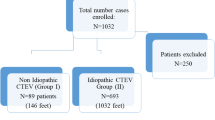Abstract
Purpose
Non-compliance with foot abduction bracing in children with clubfeet treated with the Ponseti method is the leading risk factor for deformity recurrence. A dynamic foot abduction orthosis is believed to result in improved compliance, fewer skin complications, and fewer recurrences. A case–control trial was conducted to test this hypothesis.
Methods
A prospective cohort of children with idiopathic clubfoot using a dynamic brace was compared to a historical control group treated with a standard orthosis. Compliance, skin complications, recurrence, and the need for surgical soft tissue release were compared between groups at equivalent follow-up.
Results
The dynamic and standard brace groups are equivalent in age at the start of treatment (1.9 vs. 2.9 months), number of affected feet (97 vs. 92), and severity (average of four casts required for correction in each group). Fifty-seven children were followed in each group for an average of 2 years. All were corrected initially with the Ponseti method. Compliance is higher using the dynamic brace (47/57, 81%) compared to the standard brace (21/57, 47%) (P < 0.001). The recurrence rate is lower using the dynamic brace (11/57, 19%) compared to the standard brace (22/57, 39%) (P < 0.02). Skin complications are fewer in the dynamic brace (2/57, 3%) compared to the standard brace (11/57, 19%) (P < 0.008). Most importantly, five children using the standard brace underwent posteromedial release within 2 years of treatment, compared to none in the dynamic brace group.
Conclusion
The dynamic foot abduction brace results in improved compliance, fewer recurrences, fewer skin complications, and reduced rates of surgery in idiopathic clubfoot than the traditional brace after non-operative correction with the Ponseti method.



Similar content being viewed by others
References
Heilig MR, Matern RV, Rosenzweig SD et al (2003) Current management of idiopathic clubfoot questionnaire: a multicentric study. J Pediatr Orthop 23:780–787. doi:10.1097/00004694-200311000-00017
Bor N, Herzenberg JE, Frick SL (2006) Ponseti management of clubfoot in older infants. Clin Orthop Relat Res 444:224–228. doi:10.1097/01.blo.0000201147.12292.6b
Colburn M, Williams M (2003) Evaluation of the treatment of idiopathic clubfoot by using the Ponseti method. J Foot Ankle Surg 42:259–267. doi:10.1016/S1067-2516(03)00312-0
Dobbs MB, Rudzki JR, Purcell DB et al (2004) Factors predictive of outcome after use of the Ponseti method for the treatment of idiopathic clubfeet. J Bone Joint Surg Am 86-A:22–27
Herzenberg JE, Radler C, Bor N (2002) Ponseti versus traditional methods of casting for idiopathic clubfoot. J Pediatr Orthop 22:517–521. doi:10.1097/00004694-200207000-00019
Morcuende JA, Abbasi D, Dolan LA et al (2005) Results of an accelerated Ponseti protocol for clubfoot. J Pediatr Orthop 25:623–626. doi:10.1097/01.bpo.0000162015.44865.5e
Morcuende JA, Dolan LA, Dietz FR et al (2004) Radical reduction in the rate of extensive corrective surgery for clubfoot using the Ponseti method. Pediatrics 113:376–380. doi:10.1542/peds.113.2.376
Ponseti IV, Smoley EN (1963) Congenital club foot: the results of treatment. J Bone Joint Surg Am 45-A:261–266
Thacker MM, Scher DM, Sala DA et al (2005) Use of the foot abduction orthosis following Ponseti casts: is it essential? J Pediatr Orthop 25:225–228. doi:10.1097/01.bpo.0000150814.56790.f9
Tindall AJ, Steinlechner CW, Lavy CB et al (2005) Results of manipulation of idiopathic clubfoot deformity in Malawi by orthopaedic clinical officers using the Ponseti method: a realistic alternative for the developing world? J Pediatr Orthop 25:627–629. doi:10.1097/01.bpo.0000164876.97949.6b
Cooper DM, Dietz FR (1995) Treatment of idiopathic clubfoot. A thirty-year follow-up note. J Bone Joint Surg Am 77:1477–1489
Laaveg SJ, Ponseti IV (1980) Long-term results of treatment of congenital club foot. J Bone Joint Surg Am 62:23–31
Ponseti IV (1996) Congenital clubfoot: fundamentals of treatment. Oxford University Press, New York
Haft GF, Walker CG, Crawford HA (2007) Early clubfoot recurrence after use of the Ponseti method in a New Zealand population. J Bone Joint Surg Am 89:487–493. doi:10.2106/JBJS.F.00169
Lehman WB, Mohaideen A, Madan S et al (2003) A method for the early evaluation of the Ponseti (Iowa) technique for the treatment of idiopathic clubfoot. J Pediatr Orthop B 12:133–140. doi:10.1097/00009957-200303000-00011
Aronson J, Puskarich CL (1990) Deformity and disability from treated clubfoot. J Pediatr Orthop 10:109–119
Atar D, Lehman WB, Grant AD (1991) Complications in clubfoot surgery. Orthop Rev 20:233–239
Crawford AH, Gupta AK (1996) Clubfoot controversies: complications and causes for failure. Instr Course Lect 45:339–346
Dobbs MB, Nunley R, Schoenecker PL (2006) Long-term follow-up of patients with clubfeet treated with extensive soft-tissue release. J Bone Joint Surg Am 88:986–996. doi:10.2106/JBJS.E.00114
Hutchins PM, Foster BK, Paterson DC et al (1985) Long-term results of early surgical release in club feet. J Bone Joint Surg Br 67:791–799
Ippolito E, Farsetti P, Caterini R et al (2003) Long-term comparative results in patients with congenital clubfoot treated with two different protocols. J Bone Joint Surg Am 85-A:1286–1294
Ponseti IV, Campos J (1972) Observations on pathogenesis and treatment of congenital clubfoot. Clin Orthop Relat Res 84:50–60. doi:10.1097/00003086-197205000-00011
Chotigavanichaya C, Scaduto AA, Snelson D et al (2003) A novel orthosis for the treatment of clubfoot. J Pediatr Orthop B 12:272–276. doi:10.1097/00009957-200307000-00007
Yamamoto H, Muneta T, Morita S (1998) Nonsurgical treatment of congenital clubfoot with manipulation, cast, and modified Denis Browne splint. J Pediatr Orthop 18:538–542. doi:10.1097/00004694-199807000-00027
Acknowledgments
The authors wish to acknowledge Matthew B. Dobbs, MD, for the use of his patients as the research material for this study, Melissa Kirchofer for assistance in gathering the clinical records, and Jie Zheng for the statistical analysis.
Author information
Authors and Affiliations
Corresponding author
About this article
Cite this article
Garg, S., Porter, K. Improved bracing compliance in children with clubfeet using a dynamic orthosis. J Child Orthop 3, 271–276 (2009). https://doi.org/10.1007/s11832-009-0182-9
Received:
Accepted:
Published:
Issue Date:
DOI: https://doi.org/10.1007/s11832-009-0182-9



